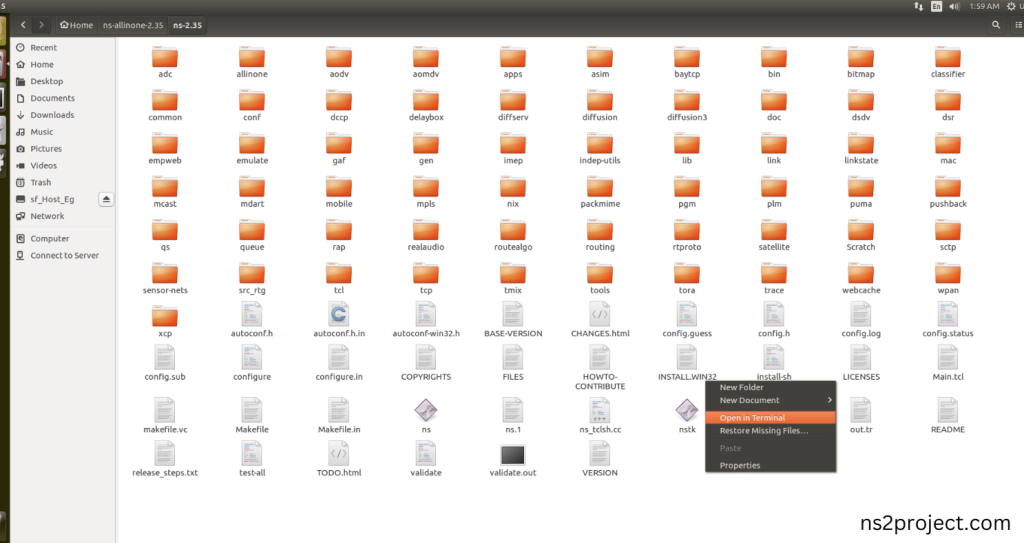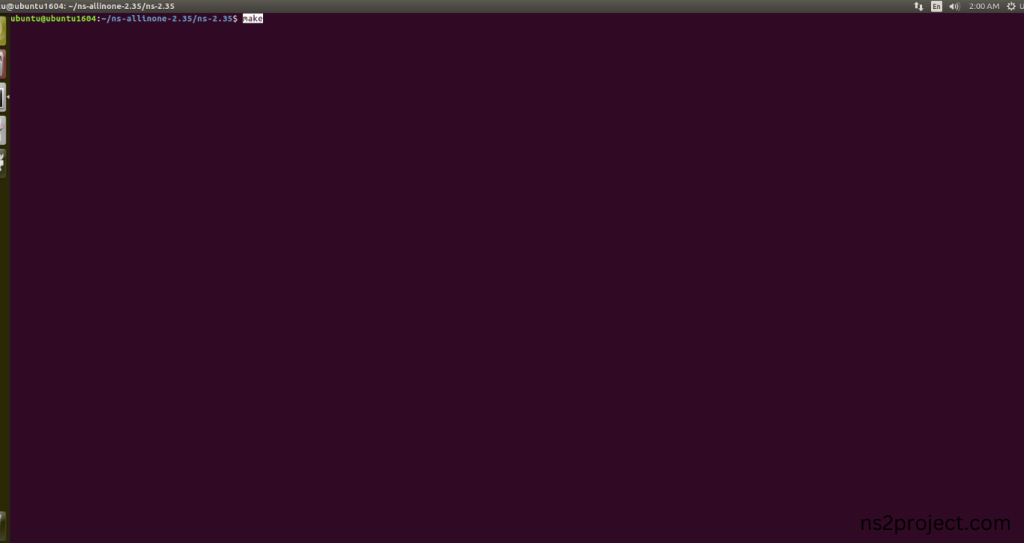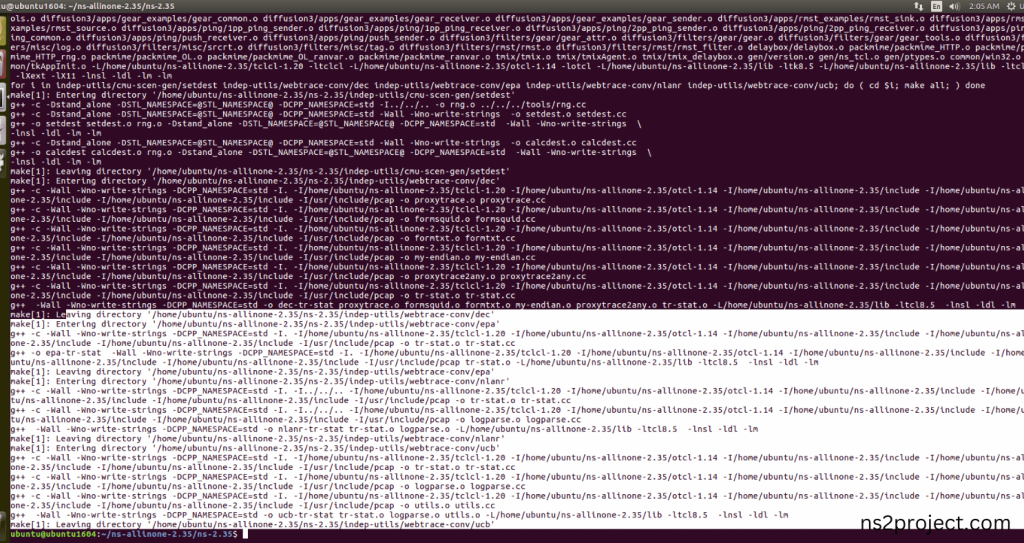How to Install RTTABLE.H Packages in Ns2
To import Rttable.h_ packages in NS2 we have outlined the steps , so if you run into any problems, contact us and we’ll provide you with the finest research answers. Get guidance from ns2projects.com team for best research guidelines on this area.
The Rttable Header helps control the routing tables, which are super important for figuring out how data packets travel through the network. The routing table keeps track of where packets need to go by linking destination addresses to the next nodes they should reach, making sure they take the right route. The rttable.h file has the information needed to create, change, and handle these tables, which is really important for both fixed and changing routing situations.
PRE-REQUISITES:
- Fresh installation of Ubuntu 16.04 LTS:
Screenshot:

2.NS-2.35 Installation:
Screenshot:

Here, Percentage (%) symbol Denotes the successful installation of the NS 2.35 Simulator.
Screenshot:

HEADER FILE VERIFICATION:
- Locate to the ns-2.35 folder:
Screenshot:

2.Create the Main.tcl file in the scratch folder:
Next we need to create the Main.tcl file by using text editor in the ns-2.35 folder.
Screenshot:

Next we need to paste the below code to the Main.tcl file and save the file in the ns-2.35 folder.
Code:
LanNode set ifqType_ Queue/DropTail
LanNode set ifqLen_ “”
LanNode set llType_ LL
LanNode set macType_ Mac
LanNode set chanType_ Channel
LanNode set phyType_ Phy/WiredPhy
LanNode set address_ “”
LanNode set mactrace_ false
LanNode instproc address {val} { $self set address_ $val }
LanNode instproc bw {val} { $self set bw_ $val }
LanNode instproc delay {val} { $self set delay_ $val }
LanNode instproc ifqType {val} { $self set ifqType_ $val }
LanNode instproc ifqLen {val} { $self set ifqLen_ $val }
LanNode instproc llType {val} { $self set llType_ $val }
LanNode instproc macType {val} { $self set macType_ $val }
LanNode instproc chanType {val} { $self set chanType_ $val }
LanNode instproc phyType {val} { $self set phyType_ $val }
LanNode instproc mactrace {val} { $self set mactrace_ $val }
LanNode instproc init {ns args} {
set args [eval $self init-vars $args]
$self instvar bw_ delay_ llType_ macType_ chanType_
$self instvar phyType_ mactrace_
$self instvar ns_ nodelist_ defRouter_ cost_
$self instvar id_ address_ channel_ mcl_ varp_
$ns instvar Node_
$self next
set ns_ $ns
set nodelist_ “”
set cost_ 1
set id_ [Node getid]
$self nodeid $id_
$ns_ add-lannode $self $id_
set Node_($id_) $self
if [Simulator hier-addr?] {
if {$address_ == “”} {
error “LanNode: use \”-address\” option \
with hierarchical routing”}} else {set address_ $id_}
$self addr $address_
set defRouter_ [new LanRouter $ns $self]
if [$ns multicast?] {
set switch_ [new Classifier/Hash/Dest 32]
$switch_ set mask_ [AddrParams McastMask]
$switch_ set shift_ [AddrParams McastShift]
$defRouter_ switch $switch_}
set channel_ [new $chanType_]
set varp_ [new VARPTable]
}
LanNode instproc addNode {nodes bw delay {llType “”} {ifqType “”} \
{macType “”} {phyType “”} {mactrace “”} {ifqLen “”}} {
$self instvar ifqType_ ifqLen_ llType_ macType_ chanType_ phyType_
$self instvar mactrace_
$self instvar id_ channel_ mcl_ lanIface_
$self instvar ns_ nodelist_ cost_ varp_
$ns_ instvar link_ Node_
if {$ifqType == “”} { set ifqType $ifqType_ }
if {$ifqLen == “”} { set ifqLen $ifqLen_ }
if {$macType == “”} { set macType $macType_ }
if {$llType == “”} { set llType $llType_ }
if {$phyType == “”} { set phyType $phyType_ }
if {$mactrace == “”} { set mactrace $mactrace_ }
set vlinkcost [expr $cost_ / 2.0]
foreach src $nodes {
set nif [new LanIface $src $self \
-ifqType $ifqType \
-ifqLen $ifqLen \
-llType $llType \
-macType $macType \
-phyType $phyType \
-mactrace $mactrace ]
set tr [$ns_ get-ns-traceall]
if {$tr != “”} {
$nif trace $ns_ $tr}
set tr [$ns_ get-nam-traceall]
if {$tr != “”} {
$nif nam-trace $ns_ $tr}
set ll [$nif set ll_]
$ll set delay_ $delay
$ll varp $varp_
$varp_ mac-addr [[$nif set node_] id] \
[[$nif set mac_] id]
set phy [$nif set phy_]
$phy node $src
$phy channel $channel_
$channel_ addif $phy
$phy set bandwidth_ $bw
set lanIface_($src) $nif
$src add-neighbor $self
set sid [$src id]
set link_($sid:$id_) [new Vlink $ns_ $self $src $self $bw 0]
set link_($id_:$sid) [new Vlink $ns_ $self $self $src $bw 0]
$src add-oif [$link_($sid:$id_) head] $link_($sid:$id_)
$src add-iif [[$nif set iface_] label] $link_($id_:$sid)
[$link_($sid:$id_) head] set link_ $link_($sid:$id_)
$link_($sid:$id_) queue [$nif set ifq_]
$link_($id_:$sid) queue [$nif set ifq_]
$link_($sid:$id_) set iif_ [$nif set iface_]
$link_($id_:$sid) set iif_ [$nif set iface_]
$link_($sid:$id_) cost $vlinkcost
$link_($id_:$sid) cost $vlinkcost}
set nodelist_ [concat $nodelist_ $nodes]
}
LanNode instproc assign-mac {ip} {return $ip }
LanNode instproc cost c {
$self instvar ns_ nodelist_ id_ cost_
$ns_ instvar link_
set cost_ $c
set vlinkcost [expr $c / 2.0]
foreach node $nodelist_ {
set nid [$node id]
$link_($id_:$nid) cost $vlinkcost
$link_($nid:$id_) cost $vlinkcost }
}
LanNode instproc cost? {} {
$self instvar cost_
return $cost_}
LanNode instproc rtObject? {} {}
LanNode instproc id {} { $self set id_ }
LanNode instproc node-addr {{addr “”}} {
eval $self set address_ $addr}
LanNode instproc reset {} {}
LanNode instproc is-lan? {} { return 1 }
LanNode instproc dump-namconfig {} {
$self instvar ns_ bw_ delay_ nodelist_ id_
$ns_ puts-nam-config \
“X -t * -n $id_ -r $bw_ -D $delay_ -o left”
set cnt 0
set LanOrient(0) “up”
set LanOrient(1) “down”
foreach n $nodelist_ {
$ns_ puts-nam-config \
“L -t * -s $id_ -d [$n id] -o $LanOrient($cnt)”
set cnt [expr 1 – $cnt]}}
LanNode instproc init-outLink {} { }
LanNode instproc start-mcast {} { }
LanNode instproc getArbiter {} {}
LanNode instproc attach {agent} {}
LanNode instproc sp-add-route {args} {}
LanNode instproc add-route {args} {}
LanNode instproc add-hroute {args} {}
Class LanIface
LanIface set ifqType_ Queue/DropTail
LanIface set macType_ Mac
LanIface set llType_ LL
LanIface set phyType_ Phy/WiredPhy
LanIface set mactrace_ false
LanIface instproc llType {val} { $self set llType_ $val }
LanIface instproc ifqType {val} { $self set ifqType_ $val }
LanIface instproc ifqLen {val} { $self set ifqLen_ $val }
LanIface instproc macType {val} { $self set macType_ $val }
LanIface instproc phyType {val} { $self set phyType_ $val }
LanIface instproc mactrace {val} { $self set mactrace_ $val }
LanIface instproc entry {} { $self set entry_ }
LanIface instproc init {node lan args} {
set args [eval $self init-vars $args]
eval $self next $args
$self instvar llType_ ifqType_ macType_ phyType_ mactrace_
$self instvar node_ lan_ ifq_ ifqLen_ mac_ ll_ phy_
$self instvar iface_ entry_ drophead_
set node_ $node
set lan_ $lan
set ll_ [new $llType_]
set ifq_ [new $ifqType_]
if {$ifqLen_ != “”} { $ifq_ set limit_ $ifqLen_ }
set mac_ [new $macType_]
if {[string compare $macType_ “Mac/802_3”] == 0} {
$mac_ set trace_ $mactrace_}
set iface_ [new NetworkInterface]
set phy_ [new $phyType_]
set entry_ [new Connector]
set drophead_ [new Connector]
$ll_ set macDA_ -1
$ll_ lanrouter [$lan set defRouter_]
$ll_ up-target $iface_
$ll_ down-target $ifq_
$ll_ mac $mac_
$ll_ ifq $ifq_
$ifq_ target $mac_
$mac_ up-target $ll_
$mac_ down-target $phy_
$mac_ netif $phy_
$phy_ up-target $mac_
$iface_ target [$node entry]
$entry_ target $ll_
set ns [Simulator instance]
$drophead_ target [$ns set nullAgent_]
$ifq_ drop-target $drophead_
$mac_ drop-target $drophead_
$ll_ drop-target $drophead_
}
LanIface instproc trace {ns f {op “”}} {
$self instvar hopT_ rcvT_ enqT_ deqT_ drpT_
$self instvar iface_ entry_ node_ lan_ drophead_
$self instvar ll_ ifq_ mac_ mactrace_
set hopT_ [$ns create-trace Hop $f $node_ $lan_ $op]
set rcvT_ [$ns create-trace Recv $f $lan_ $node_ $op]
set enqT_ [$ns create-trace Enque $f $node_ $lan_ $op]
set deqT_ [$ns create-trace Deque $f $node_ $lan_ $op]
set drpT_ [$ns create-trace Drop $f $node_ $lan_ $op]
if {[string compare $mactrace_ “true”] == 0} {
set macdrpT_ [$ns create-trace Collision $f $node_ $lan_ $op]
set macdrophead_ [new Connector]
$mac_ drop-target $macdrophead_
$macdrophead_ target $macdrpT_}
$hopT_ target [$entry_ target]
$entry_ target $hopT_
$rcvT_ target [$iface_ target]
$iface_ target $rcvT_
$enqT_ target [$ll_ down-target]
$ll_ down-target $enqT_
$deqT_ target [$ifq_ target]
$ifq_ target $deqT_
$drpT_ target [$drophead_ target]
$drophead_ target $drpT_
}
LanIface instproc nam-trace {ns f} {
$self instvar hopT_ rcvT_ enqT_ deqT_ drpT_
if [info exists hopT_] {
$hopT_ namattach $f
} else {
$self trace $ns $f “nam”}
$rcvT_ namattach $f
$enqT_ namattach $f
$deqT_ namattach $f
$drpT_ namattach $f
}
LanIface instproc add-receive-filter filter {
$self instvar mac_
$filter target [$mac_ target]
$mac_ target $filter
}
Class Vlink
Vlink instproc up? {} {
return “up”
}
Vlink instproc queue {{q “”}} {
eval $self set queue_ $q
}
Vlink instproc init {ns lan src dst b d} {
$self instvar ns_ lan_ src_ dst_ bw_ delay_
set ns_ $ns
set lan_ $lan
set src_ $src
set dst_ $dst
set bw_ $b
set delay_ $d
}
Vlink instproc src {} { $self set src_ }
Vlink instproc dst {} { $self set dst_ }
Vlink instproc dump-nam-queueconfig {} {}
Vlink instproc head {} {
$self instvar lan_ dst_ src_
if {$src_ == $lan_ } {
return “”
} else {
set src_lif [$lan_ set lanIface_($src_)]
return [$src_lif entry]}
}
Vlink instproc cost c { $self set cost_ $c}
Vlink instproc cost? {} {
$self instvar cost_
if ![info exists cost_] {
return 1}
return $cost_
}
LanRouter instproc init {ns lan} {
$self next
if [Simulator hier-addr?] {
$self routing hier
} else {
$self routing flat }
$self lanaddr [$lan node-addr]
$self routelogic [$ns get-routelogic]
}
Node instproc is-lan? {} { return 0 }
Simulator instproc newLan {nodelist bw delay args} {
set lan [eval new LanNode $self -bw $bw -delay $delay $args]
$lan addNode $nodelist $bw $delay
return $lan
}
Simulator instproc make-lan { args } {
set t [lindex $args 0]
set mactrace “false”
if { $t == “-trace” } {
set mactrace [lindex $args 1]
if {$mactrace == “on” } {
set mactrace “true”}}
if { $t == “-trace” } {
set nodelist [lindex $args 2]
set bw [lindex $args 3]
set delay [lindex $args 4]
set llType [lindex $args 5]
set ifqType [lindex $args 6]
set macType [lindex $args 7]
set chanType [lindex $args 8]
set phyType [lindex $args 9]
set ifqLen [lindex $args 10]
} else {
set nodelist [lindex $args 0]
set bw [lindex $args 1]
set delay [lindex $args 2]
set llType [lindex $args 3]
set ifqType [lindex $args 4]
set macType [lindex $args 5]
set chanType [lindex $args 6]
set phyType [lindex $args 7]
set ifqLen [lindex $args 8] }
if { $llType == “” } {
set llType “LL”
}
if { $ifqType == “” } {
set ifqtype “Queue/DropTail”}
if { $macType == “” } {
set macType “Mac”
}
if { $chanType == “” } {
set chanType “Channel”
}
if { $phyType == “”} {
set phyType “Phy/WiredPhy”
}
if {[string compare $macType “Mac/Csma/Cd”] == 0} {
puts “Warning: Mac/Csma/Cd is out of date”
puts “Warning: Please use Mac/802_3 to replace Mac/Csma/Cd”
set macType “Mac/802_3”
}
set lan [new LanNode $self \
-bw $bw \
-delay $delay \
-llType $llType \
-ifqType $ifqType \
-ifqLen $ifqLen \
-macType $macType \
-chanType $chanType \
-phyType $phyType \
-mactrace $mactrace]
$lan addNode $nodelist $bw $delay $llType $ifqType $macType \
$phyType $mactrace $ifqLen
return $lan
}
Screenshot:

3.Open the Terminal:
Next, we need to launch the terminal by right clicking the mouse in the ns-2.35 location.
Screenshot:

Screenshot:

4.NS-2.35 Configuration && Building Process:
Next, we need to configure and build the ns-2.35 folder to make the Created files need to work in ns-2.35 configuration.
Command: “./make”
Screenshot:

Screenshot:

Screenshot:

Here, NS-2.35 Building process completed successfully.
5.Importing Rttable.h:
Here we imported the Rttable.h header file code indirectly accessed the Rttable class used in the Tcl script (set defRouter_ [new LanRouter $ns $self]), LanRouter class involved with routing logic, potentially interacting with rttable and rt_entry for managing routes in this example program. Here we highlighted the code line that highlighted which is internally accessed Rttable.h that we will show class file that used in this code via Routing folder.
Screenshot:

Screenshot:

Here we will show the header file by opening Rttable.h file to show the class or function imported from the Rttable.h in the example code. Rttable.h is used (set defRouter_ [new LanRouter $ns $self]), LanRouter class involved with routing logic, potentially interacting with rttable and rt_entry function and classes for managing routes during the simulation.
Screenshot:

Screenshot:

6.Executing the Example Program for Rttable Header:
Then we need to run the Example program for Rttable Header to view output of the program.
Command: “./ns Main.tcl && nam out.nam”
Screenshot:

Here we shown the output of the example program by using Rttable.h.
Screenshot:

Screenshot:

Screenshot:

In the NS 2.35 Simulation Example Program, the Rttable.h Header file is successfully imported.







